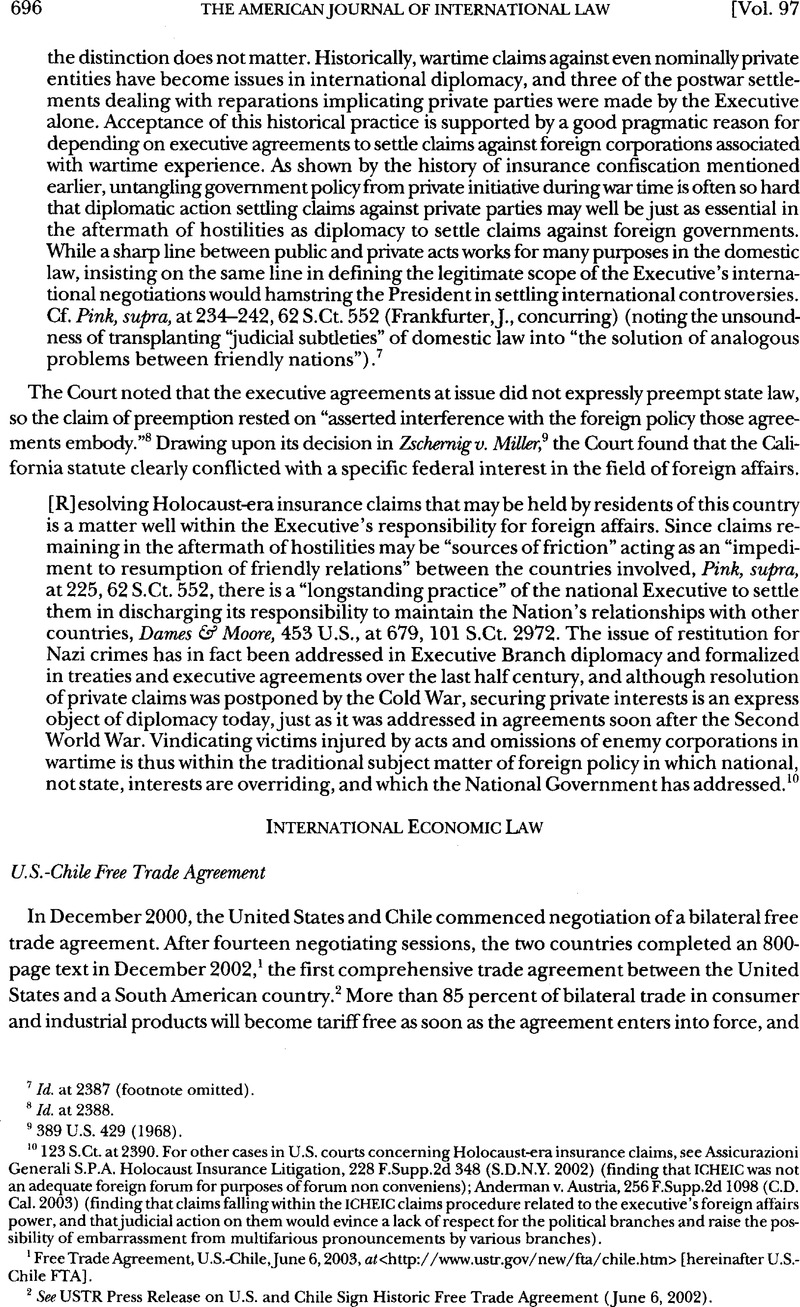No CrossRef data available.
Article contents
U.S.- Chile Free Trade Agreement
Published online by Cambridge University Press: 10 March 2017
Abstract

- Type
- Contemporary Practice of the United States Relating to International Law
- Information
- Copyright
- Copyright © American Society of International Law 2003
References
1 Free Trade Agreement, U.S. Chile June 6,2003, at <http://www.ustr.gov/new/fta/chile.htm> [hereinafter U.S.Chile FTA].
2 See USTR Press Release on U.S. and Chile Sign Historic Free Trade Agreement (June 6, 2002).
3 See U.S.-Chile FTA, supra note 1, ch. 3.
4 Id.
5 Id., ch. 11.
6 Id., ch. 17.
7 Id., chs. 18–19.
8 Id., Art. 22.16.
9 Id., ch. 10, sec. B (investor-state disputes); ch. 22 (interstate disputes). The dispute settlement provisions are based largely on chapters 11 and 20 of the North American Free Trade Agreement (NAFTA), but with certain modifications. See NAFTA, Dec. 17, 1992, Can.-Mex.-U.S., 32 ILM 289 & 605, 639, 693 (1993) (entered into force Jan. 1, 1994).
10 U.S.-Chile FTA, supra note 1, Arts. 10.2, .3.
11 Id., Art. 10.4. This clarification is a U.S. reaction to the decision by a NAFTA panel that NAFTA Article 1105 (1) establishing a minimum standard of treatment calls for protections beyond those contained in customary international law. See Murphy, Sean D., United States Practice in International Law, 1999–2001, 237–38, 241 (2002)Google Scholar; see also Mondev lnt’l v. United States, Award, para. 120 (NAFTA Ch. 11 Arb.Trib. Oct. 11,2002), at<http://www.state.gov/documents/organization/14442.pdf> .
12 U.S.-Chile FTA, supra note 1, Art. 10.4(2) (a), (b).
13 This language differs from the comparable language in NAFTA, which states that “no Party may directly or indirectly nationalize or expropriate an investment of an investor of another Party in its territory or take a measure tantamount to nationalization or expropriation of such an investment.” NAFTA, Art 1110(1) (emphasis added). Some parties in NAFTA dispute resolution cases have argued that the NAFTA language encompassed actions falling outside traditional law on expropriation. Although NAFTA panels did not embrace that interpretation, see Metalclad Corp. v. Mexico, Award, para. 103 (NAFTA Ch. 11 Arb. Trib. Aug. 30, 2000), Pope & Talbot, Interim Award, para. 104 (NAFTA Ch. 11 Arb. Trib. June 26,2000), S.D. Myers, Inc. v. Canada, Partial Award, paras. 279–88 (NAFTA Ch. 11 Arb. Trib. Nov. 13,2000), excluding the reference to “ tantamount” in the agreement with Chile is expected to provide greater clarity in the scope of measures at issue.
14 U.S.-Chile FTA, supra note 1, Art. 10.9(1).
15 Id., Annex 10–D, paras. 3, 4.
16 Id., An. 10.12.
17 Trade Act of 2002, Pub. L. No. 107–210,116 Stat. 933 (2002) (contains as Division B the Bipartisan Trade Promotion Authority Act of 2002).
18 See Message to the Congress Transmitting Notification of Intention to Enter into a Free Trade Agreement with Chile, 39 Weekly Comp. Pres. Doc. 126 (Jan. 30, 2003).
19 See USTR Press Release on United States and Chile Sign Historic Free Trade Agreement (June 6,2003), at <http://www.ustr.gov/new/fta/chile.htm>.
20 Int’l Trade Comm. , U.S. Chile Free Trade Agreement: Potential Economywide and Selected Sectoral Effects, at x (June 2003), at <ftp://ftp.usitc.gov/pub/reports/studies/pub3605.pdf>.
21 U.S.-Chile FTA, supra note 1, Art. 24.4.
22 5 U.S.C. §552 (2000).
23 Ctr. for Int’l Envtl. Law v. U.S.T.R., 237 F.Supp.2d 17 (D.D.C. 2002).
24 Ctr. for Int’l Envtl. Law v. U.S.T.R., 240 F.Supp.2d 21 (D.D.C. 2003).
25 See Brevetti, Rosella, Trade Officials Say FOIA Case Has Had Chilling Effect on Disclosure, 20 Int’l Trade Rep. (BNA) 705 (Apr. 24, 2003)Google Scholar.


